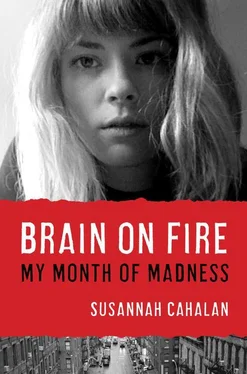The neurosurgery resident came by to shave my head. The doctor shaved a good five-inch diameter section from my head, but, although I appeared fully conscious, I did not scream, call out, or cry. My dad again admired this strength, though it’s possible I simply had no idea what was going on. I sat on the bed unfazed with my head wrapped in a towel, as if I had just received a spa treatment.
Fighting back tears, my dad knelt beside me.
“Remember what I told you. What is the strategy?”
“One step at a time.”
“What is the slope of the line?”
“Positive.”
Neurosurgeon Dr. Werner Doyle donned his surgical gown and prepped for surgery. He entered the operating room flanked by a scrub nurse, a circulating nurse, and an anesthesiologist. Despite the relative safety of this procedure, any number of things could still go wrong: they could have chosen the wrong location to dissect, and there is always a risk of infection or mistake with any type of surgery, especially the kinds involving the brain. But still, brain biopsies were simple compared to the more complex epilepsy surgeries that he had grown accustomed to performing over the years.
A new MRI had been loaded into his office computer and workstation, and it guided the surgeon through a process called frameless stereotactic neurosurgery, which involves the visual mapping of the brain in both three and two dimensions so that the surgeon can swiftly and accurately target one specific area of the brain—in this case, the right frontal cortex. He had already chosen an area, one without any large draining veins, farthest away from the parts of the brain responsible for motor functions. My gurney was rolled over to the operating table, my scalp shaved and cleaned. Then they put me under general anesthesia.
“Count down from 100,” the anesthesiologist instructed.
“100… 99…”
As my eyes closed, they secured the head holder onto my temples to keep me still. With a scalpel, Dr. Doyle made an S-shape incision, 4 centimeters from the midline of the scalp over the right frontal region. The arm of the S extended just behind my hairline. He parted the skin with a sharp blade and gripped each side with retractors. Grasping a high-speed drill in his hands like a skillful carpenter, he pressed it down on the skull, making a “burr hole,” or a 1-centimeter-diameter aperture through the bone of the skull. He then went over the burr hole with a craniotome, a bigger drill, grinding the bone into dust. He removed a 3-centimeter piece of the bone plate, exposing the dura, or the outermost, leathery, protective layer of the brain, and saved a section to send for testing along with the brain tissue.
With a fine #11 blade and a dissector, he cut several cubes of tissue, equaling about 1 cubic centimeter in volume, which included white matter (strands of nerve fibers) and gray matter (the cell bodies of neurons). He set aside specimens for future studies and an extra sample to be frozen in case other tests were needed. He swabbed the brain matter and stopped the blood flow using cottonoids, highly absorbent synthetic fibers.
He then very carefully stitched a dura graft onto the outer layer of the brain, suturing it together, and then reattached the bone plate. He pushed the plate to one side, butting it up against the existing bone so that it would fuse, and then secured the plate using screws and a small metal plate. He ended the procedure by returning the outer layer of skin to its original position, and closing the scalp with metal staples. The whole procedure took four hours.
“Count down from 100,” a disembodied voice says.
“100… 99… 98…”
Darkness.
Blink. Blink. Blink. “I’m still awake.”
Darkness.
A crowded recovery room. I’m alone. There’s a family to the right of me, surrounding another patient. Where are my parents?
Then I see them. Mom and Dad. I can’t move.
Then Stephen and Allen. I try to raise my arm slightly to wave; it feels as heavy as a fifty-pound weight.
Darkness.
“Thirsty.” My voice is hoarse. “Thirsty.”
“Here,” a brusque nurse says, shoving a water-soaked sponge into my mouth. The texture is unpleasant but the water is a godsend. I suck and suck. “Thirsty.” She shoves another one in my mouth. I hear the parents beside me feeding their kid ice chips. I raise my arm. I want some. A male nurse approaches. “Ice.” He brings me a few ice chips and places them on my tongue. I can hear the female nurse telling him not to give me water. “She can’t have any water. Just ignore her.”
“Water, water,” I moan.
She approaches. “I’m sorry but you can’t have any more.”
“I’m going to tell everyone how you treated me. I’m going to tell everyone when I get out of here.”
“What did you say?” Her tone scares me.
“Nothing.”
Darkness.
I’m in a claustrophobic one-person room. I have to pee. I have to pee. I push. My catheter comes undone and the urine sprays all over the bed. I call out. A nurse comes in.
“I peed.”
Another nurse joins her. They turn me on my left side, remove the bedding, wash me with warm towels, and spritz me with something. Then they turn me over to the right side and repeat. It feels nice. But I can’t move. I push hard with my brain, trying to wiggle my toes. I push so hard that I get a headache. My toes don’t move.
“I can’t move my legs,” I call out.
Many hours after the surgery, around 11:00 p.m., a nurse informed my dad, who had chosen to wait for news while everyone else went home at the staff’s insistence, that I had been moved from the recovery room into the ICU. They didn’t invite him in to see me, but he wandered into the unit anyway, unaccompanied. The floor consisted of a handful of bays, one patient in each. There were nurses everywhere, but no one even looked twice at him. He peeked into each bay until he spotted me.
There I was, semiconscious, propped up on pillows with my head wrapped in white gauze like some kind of sick Persian princess. I was attached to monitors and machines that beeped and groaned and had been wrapped up in nude compression stockings to keep my blood pressure normal. When he caught my eye, I instantly recognized him, which didn’t always happen. We hugged.
“The worst is behind you, Susannah.”
“Where’s Mom?” I asked.
“She will see you tomorrow,” he said. He could tell I was upset that my mother hadn’t come, even though it had been the right decision for her to go home that night. Then: “I can’t feel my legs, Dad.” I sounded convinced.
“Are you sure, Susannah?” my dad asked, turning white with fear. This had been the worry all along, that they would do permanent damage by messing with my brain.
“Yes. I can’t move them.”
My dad immediately called in a young resident, who came in and examined me, then rushed me out for an emergency MRI. My dad silently hurried beside the gurney, holding my hand until the MRI technician whisked me into the room, telling my dad to wait. In those thirty minutes, he would later sigh, he lost five years off his life. But the young resident eventually emerged to tell him that everything looked fine.
My dad stayed with me until I fell asleep. Then he went home and slid into bed, prayed, and fell into a restless slumber.
Читать дальше













